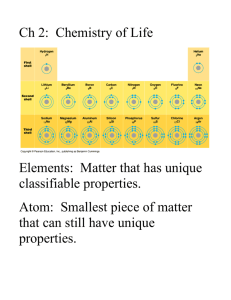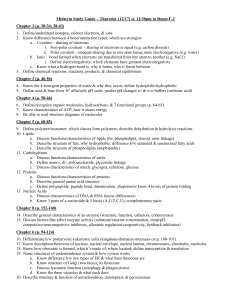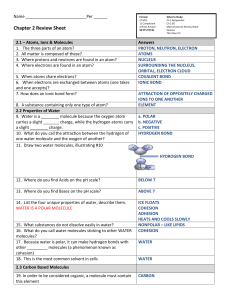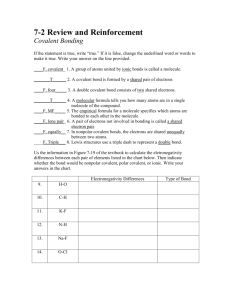CHAPTER 2
advertisement
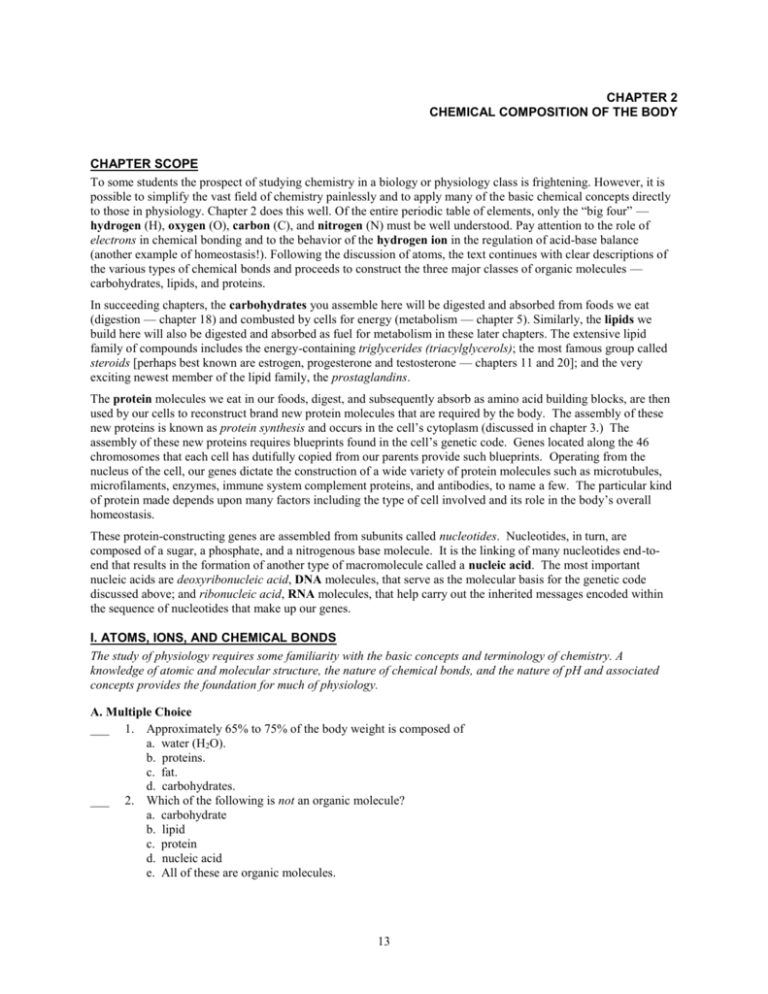
CHAPTER 2 CHEMICAL COMPOSITION OF THE BODY CHAPTER SCOPE To some students the prospect of studying chemistry in a biology or physiology class is frightening. However, it is possible to simplify the vast field of chemistry painlessly and to apply many of the basic chemical concepts directly to those in physiology. Chapter 2 does this well. Of the entire periodic table of elements, only the “big four” — hydrogen (H), oxygen (O), carbon (C), and nitrogen (N) must be well understood. Pay attention to the role of electrons in chemical bonding and to the behavior of the hydrogen ion in the regulation of acid-base balance (another example of homeostasis!). Following the discussion of atoms, the text continues with clear descriptions of the various types of chemical bonds and proceeds to construct the three major classes of organic molecules — carbohydrates, lipids, and proteins. In succeeding chapters, the carbohydrates you assemble here will be digested and absorbed from foods we eat (digestion — chapter 18) and combusted by cells for energy (metabolism — chapter 5). Similarly, the lipids we build here will also be digested and absorbed as fuel for metabolism in these later chapters. The extensive lipid family of compounds includes the energy-containing triglycerides (triacylglycerols); the most famous group called steroids [perhaps best known are estrogen, progesterone and testosterone — chapters 11 and 20]; and the very exciting newest member of the lipid family, the prostaglandins. The protein molecules we eat in our foods, digest, and subsequently absorb as amino acid building blocks, are then used by our cells to reconstruct brand new protein molecules that are required by the body. The assembly of these new proteins is known as protein synthesis and occurs in the cell’s cytoplasm (discussed in chapter 3.) The assembly of these new proteins requires blueprints found in the cell’s genetic code. Genes located along the 46 chromosomes that each cell has dutifully copied from our parents provide such blueprints. Operating from the nucleus of the cell, our genes dictate the construction of a wide variety of protein molecules such as microtubules, microfilaments, enzymes, immune system complement proteins, and antibodies, to name a few. The particular kind of protein made depends upon many factors including the type of cell involved and its role in the body’s overall homeostasis. These protein-constructing genes are assembled from subunits called nucleotides. Nucleotides, in turn, are composed of a sugar, a phosphate, and a nitrogenous base molecule. It is the linking of many nucleotides end-toend that results in the formation of another type of macromolecule called a nucleic acid. The most important nucleic acids are deoxyribonucleic acid, DNA molecules, that serve as the molecular basis for the genetic code discussed above; and ribonucleic acid, RNA molecules, that help carry out the inherited messages encoded within the sequence of nucleotides that make up our genes. I. ATOMS, IONS, AND CHEMICAL BONDS The study of physiology requires some familiarity with the basic concepts and terminology of chemistry. A knowledge of atomic and molecular structure, the nature of chemical bonds, and the nature of pH and associated concepts provides the foundation for much of physiology. A. Multiple Choice ___ 1. Approximately 65% to 75% of the body weight is composed of a. water (H2O). b. proteins. c. fat. d. carbohydrates. ___ 2. Which of the following is not an organic molecule? a. carbohydrate b. lipid c. protein d. nucleic acid e. All of these are organic molecules. 13 ___ 3. ___ 4. ___ 5. ___ 6. ___ 7. ___ 8. ___ 9. ___ 10. ___ 11. The atomic mass of an atom is determined by the total mass of its a. protons and neutrons. b. neutrons and electrons. c. electrons and protons. d. protons only. e. electrons only. The atomic number of an atom is given by the total number of its a. protons and neutrons. b. neutrons and electrons. c. electrons and protons. d. protons only. e. electrons only. The second energy shell, or orbital, of an atom contains a maximum of ___________ electrons. a. two b. four c. six d. eight e. eighteen The bond between two adjacent water molecules is a(n) a. hydrogen bond. b. polar covalent bond. c. nonpolar covalent bond. d. ionic bond. Solution A has a pH of 10 and solution B has a pH of 2. Which of the following statements about these two solutions is true? a. Solution A has a higher H+ concentration than solution B. b. Solution B is basic. c. Solution A is acidic. d. All of these statements are true. e. None of these statements is true. The class of organic molecules featuring a carbonyl group within the carbon chain is known as a(n) a. organic acid. b. aldehyde. c. ketone. d. alcohol. When a bond is formed between two atoms that not only share their valence electrons but also share them equally, such a bond is formally called a(n) a. hydrogen bond. b. polar covalent bond. c. nonpolar covalent bond. d. ionic bond. Because the oxygen atom within a water molecule tends to pull on each of the valence electrons belonging to the two adjoining hydrogen atoms resulting in an uneven sharing of electrons, the resulting bond is formally called a(n) a. hydrogen bond. b. polar covalent bond. c. nonpolar covalent bond. d. ionic bond. The _______ bond between the sodium atom and the chlorine atom in a molecule of table salt, sodium chloride (Na+Cl-) is fairly weak and tends to separate or dissociate when dissolved in water. a. ionic b. hydrogen c. covalent d. hydrophobic 14 Pure water has a H+ concentration of _______ molar at 25°C, and thus has a pH of ______. a. 10-4; 14 b. 10-7; 7 c. 10-14; 7 d. 10-4; 4 ___ 13. A carboxyl group is a functional group that can be attached to a hydrocarbon chain, whereupon the newly formed organic molecule becomes a(n) a. ketone. b. alcohol. c. organic acid. d. phosphate. ___ 12. B. True or False/Edit ___ 14. By definition, organic molecules are those that must be composed of at least one hydrogen atom. ___ 15. The electrons of the outermost orbital, which participate in chemical reactions and form chemical bonds, are known as valence electrons. ___ 16. Atoms may exist as isotopes, which have the same atomic mass but a different atomic numbers. ___ 17. An atom that gains more electrons than it has protons becomes a negatively charged ion called a cation. ___ 18. In ionic bonds the electrons are not shared at all. ___ 19. A base is usually a molecule that can combine with H +, remove that H+ from solution, and thus lower the overall pH value of the solution. ___ 20. Basic (alkaline) solutions have a pH of less than 7, whereas acidic solutions have a pH between 7 and 14. ___ 21. An acid is defined as a molecule that can release protons (H+) into a solution; and is therefore, a “proton donor.” ___ 22. Excessive vomiting causes the loss of gastric (stomach) acid resulting in a rise in the blood concentration of free H+ that could be measured as a fall in the blood pH. ___ 23. A person experiencing such excessive vomiting, therefore, would be in a condition described as an alkalosis. ___ 24. When two carbon atoms share two pairs of electrons, they have a double covalent bond, and each carbon atom can bond with a maximum of only two additional atoms. ___ 25. Stereoisomers may have exactly the same arrangement of atoms in exactly the same sequence yet may differ in their 3-dimensional orientations in space. ___ 26. Bicarbonate ion (HCO3–) is the major buffer of the blood. ___ 27. Hydroxyl groups are normally found on one end of the carbon chain (for example, an alcohol) rather than found near the middle of organic molecules. ___ 28. Enzymes in the cells of the body will only recognize D-amino acid and L-sugar stereoisomers during catalyzed reactions. C. Label the Figure and Application—Functional Groups of Organic Molecules Here are the more important functional groups that are part of organic molecules. These groups appear often in various figures that follow. Study the structures of these functional groups and be able to recognize, categorize, and name them quickly, even when they appear as part of larger, more complex molecules. With practice, you will discover that new and different molecules will appear “friendlier” as you recognize familiar functional groups and learn how to predict their behavior in the body. Study Figure 2.1 below and fill in the shaded boxed areas to the right with the correct functional group. (You can check your answers against Figure 2.10 in the text.) 15 Figure 2.1 Various functional groups of organic molecules. The general symbol for a functional group is “R.” II. CARBOHYDRATES AND LIPIDS Carbohydrates are a class of organic molecules that includes monosaccharides, disaccharides, and polysaccharides. All of these molecules are based on a characteristic ratio of carbon, hydrogen, and oxygen atoms. Lipids are a category of diverse organic molecules that share the physical property of being nonpolar, and thus insoluble in water. A. Multiple Choice ___ 29. The general formula of a carbohydrate molecule is a. (H2O)C. b. H2OCC. c. CH2O. d. H2O. ___ 30. Which of the following molecules is not a disaccharide? a. sucrose b. lactose c. galactose d. maltose 16 ___ 31. Extra sugar molecules in the body are condensed and stored in the liver and muscles as a polymer known as a. glycogen. b. glucose. c. galactose. d. glucagons. e. starch. ___ 32. Ketone bodies can be formed by the liver from the hydrolysis (breakdown) of a. carbohydrates. b. proteins. c. free fatty acids (from triglycerides). d. nucleic acids. e. prostaglandins. ___ 33. Which of the following molecules forms an integral part of micelles floating in the blood and can also function as a surfactant, decreasing the surface tension of water? a. glycogen b. water c. protein d. phospholipid e. nucleic acid ___ 34. Which of the following organs does not secrete steroid hormones? a. liver b. ovary c. adrenal cortex d. testes B. True or False/Edit ___ 35. Sucrose is a disaccharide of glucose and galactose. ___ 36. Starch is a polysaccharide of glucose, stored in plants. ___ 37. Dehydration synthesis is the use of water to split larger compounds into smaller compounds (digestion). ___ 38. Lipid molecules are characterized by being insoluble in nonpolar solvents, such as water. ___ 39. A fatty acid chain showing any number of double covalent bonds, within which each carbon atom binds to only one hydrogen atom, is known as a saturated fatty acid chain. ___ 40. Triglycerides or triacylglycerols are also known as neutral fats because the attached fatty acid groups can no longer release H+ and function as acids; and therefore, do not alter the acid-base balance. ___ 41. Phospholipid molecules contain both polar and nonpolar sections, which contribute to the hydrophilic and hydrophobic properties, respectively, of these molecules. ___ 42. Cholesterol is the precursor or raw material used by the body for the synthesis of steroid hormones such as testosterone, estrogen, progesterone, and hydrocortisone. ___ 43. Prostaglandins are produced by and are active in almost all organs of the body where they serve a variety of regulatory functions. III. PROTEINS Proteins are large molecules composed of amino acid subunits. Since there are twenty different types of amino acids that can be used in constructing a given protein, the variety of protein structures is immense. This variety allows each type of protein to perform very specific functions. A. Multiple Choice ___ 44. The approximate number of amino acids that form proteins is a. eight. b. twelve. c. twenty. d. twenty-three. e. forty-six. 17 ___ 45. In the formation of peptide bonds between two amino acids a. condensation or dehydration synthesis occurs. b. the amino group of one binds with the carboxyl group of the other. c. a covalent bond is formed between the two amino acids. d. water is removed from between the two amino acids. e. All of these occur in the formation of peptide bonds. ___ 46. The alpha () helical (spiral) structure or beta () pleated sheet structure of a protein best describes its ___________ structure. a. primary b. secondary c. tertiary d. quaternary ___ 47. Heat irreversibly changes the ___________ structure of proteins. a. primary b. secondary c. tertiary d. quaternary ___ 48. Hemoglobin and cytochrome molecules are good examples of conjugated (combined) proteins in which the protein is bound to a. carbohydrate molecules. b. lipid molecules. c. pigment molecules. ___ 49. Which of the following is not a function of proteins? a. add structure or strength to connective tissues b. prevent water loss through the skin c. catalyze reactions as enzymes d. serve as antibodies, preventing infection e. serve as cell membrane receptors and carrier molecules f. All of these are functions of proteins. B. True or False/Edit ___ 50. The specific sequence of amino acids is part of the genetic information prescribed by the sequence of nucleic acids. ___ 51. Differences among proteins are due to differences in the functional or R groups of each amino acid. ___ 52. Disulfide (S-S) bonds between neighboring amino acids are strong covalent bonds stabilizing the secondary structure of proteins. ___ 53. Lipoproteins are found in cell membranes and in the plasma or fluid portion of the blood. ___ 54. No other type of molecule in the body serves a wider variety of functions as those served by the proteins. IV. NUCLEIC ACIDS Nucleic acids include the macromolecules DNA and RNA, which are critically important in genetic regulation, and the subunits from which these molecules are formed. These subunits are known as nucleotides. A. Multiple Choice ___ 55. A five-carbon (pentose) sugar, a phosphate group, and a nitrogenous base can combine to form a larger, important molecule known as a a. protein. b. nucleic acid. c. nucleotide. d. phospholipids. ___ 56. In which of the following relationships is the law of complementary base pairing not enforced? a. guanine pairs with cytosine b. cytosine pairs with thymine c. thymine pairs with adenine 18 ___ 57. The term, genome, refers to the a. nucleus of the cell. b. nucleolus of the cell. c. smallest unit of inheritance. d. collection of all genes in a cell. ___ 58. The nitrogenous base found in DNA that is not found in RNA, is a. adenine. b. guanine. c. thymine. d. cytosine. e. uracil ___ 59. Which of the following is not a specific type of ribonucleic acid (RNA) molecule? a. messenger b. mitochondrial c. transfer d. ribosomal B. True or False/Edit ___ 60. Although DNA is the largest molecule in the cell, it has a simpler structure than that of most proteins. ___ 61. Following the law of complementary base pairing, the number of purine bases used to assemble a DNA molecule must be equal to the number of pyrimidine bases. ___ 62. DNA and mRNA are polynucleotides that are made up of two nucleotide chains, and so are called double-stranded. ___ 63. All three types of RNA are formed under the direction of the genetic information contained in the DNA of the nucleus. CHAPTER REVIEW Please Note: An additional review of chemistry is summarized in Appendix A of the laboratory manual entitled, A Laboratory Guide to Human Physiology, Concepts and Clinical Applications, by Stuart I. Fox, that accompanies our textbook. A. Completion 64. _______________ spheres are formed when water molecules surround charged particles or _______________ which, in turn, attract other water molecules. 65. Molecules that are soluble in water and, therefore, _______________ (polar/nonpolar) are said to be hydro _______________ (philic/phobic); while molecules composed of covalent bonds such as fat molecules are _______________ (polar/nonpolar), express few charges, are insoluble in water, and are said to be hydro ______________ (philic/phobic). 66. Hydrogen bonding between water molecules is responsible for many of the physical properties of water, including _______________ tension and _______________ action. 67. An acid is defined as a molecule that can _______________ (gain/release) protons (H +) in a solution; thus an acid _______________ (raises/lowers) the number of H+ in a solution and ______________ (raises/lowers) the pH. 68. Complete this bicarbonate-carbonic acid buffer reaction: _______________ + H+ H2CO3 (bicarbonate) (_______________) (______________) 69. The three hexose sugars that are structural isomers with the formula C6H12O6, are ______________, _______________, and _______________. 70. Animal starch, or _______________, is composed of repeating units of ______________ molecules and is stored in both the _______________ and muscle tissue. 19 71. Triglycerides (triacylglycerols) are lipids formed _______________ by of one molecule of _______________ with _______________(#) molecules of ______________ acids. 72. The structure of steroid molecules is unique. They feature _______________(#) six-carbon rings joined to one _______________ - carbon ring. This structure is seen in the important steroid molecule of the body known as ______________, which is the precursor for most steroid hormones in the body. These steroids are primarily synthesized by the _______________, _______________, and _______________ cortex tissues. 73. Proteins are composed of different combinations of _______________(#) individual amino acids, whose amino and _______________ groups bind to form _______________ bonds; and whose functional or R groups interact to twist the protein into a helix (_______________ structure) and then bend and fold onto itself (______________ structure) to form the active protein. 74. Specific regulator proteins found in cell membranes may serve as _______________ for other molecules such as hormones, while specific transport molecules are called protein ____________. B. Crossword Puzzle — Chemical Composition of the Body Across Down 1. 3. 7. 9. 11. 12. 13. 2. bond where electrons are shared equally 4. carbohydrates are composed of carbon, hydrogen, and ______ 5. pigment portion of hemoglobin 6. organic acid functional group 8. bonds in which electrons are shared between two or more atoms 10. fatty acids with no double bonds 11. organic molecule with primary, secondary, and tertiary structure 15. covalent, hydrogen, or ionic ______ 18. substance that binds or releases H+ ions in order to stabilize pH 20. nuclear particle most involved in the formation of chemical bonds 22. composed of a nucleus and orbital electron(s) 23. molecule with three six-carbon rings and one five-carbon ring 26. functional group of an amino acid is the R or ______ 27. chemical symbol for chlorine 28. solution with pH less than 29. secondary alpha() _________ protein structure 32. prefix meaning “one” 33. table salt 14. 16. 17. 19. 21. 24. 25. 30. 31. 34. 35. 36. major buffer molecule of the blood weak bond holding water molecules together molecules containing carbon and hydrogen glycoprotein secreted from goblet cells common scale of acid-base units element symbol for sodium organic molecule containing carbonyl functional groups element with four valence electrons; forms four bonds functional group found on an alcohol steroids synthesized by the gonads long fatty acid chains with double bonds present what an atom becomes after losing electrons from outermost orbital substance required in hydrolysis reactions water is an example of a ______ solvent solution in which the pH > 7.0 also known as “neutral” fat the genetic code macromolecule what results when one or more electrons are gained any charged element or compound 20 C. Essay Essay Tutorial This essay tutorial will answer the first essay question found in the “Test Your Understanding of Concepts and Principles” section located at the end of each chapter in your Human Physiology textbook. Please read the following question carefully and let me guide you through one possible answer. Watch for helpful tips and general suggestions on writing the essay or short-answer questions. Learn to spot key words in the questions such as “Compare” and “contrast” that I have indicated in the following material in bold-face type, and to outline your ideas quickly on a separate piece of paper. This will help you organize your thoughts, express yourself clearly, and result in better test scores. Using similar techniques, try the bonus essay questions that follow on your own. Enjoy! 21 75. Compare and contrast nonpolar covalent bonds, polar covalent bonds, and ionic bonds. Answer. “Compare and contrast” calls for a list of similarities and differences among the three types of bonds, as follows: Bond Type Nonpolar covalent Similarities and Differences Share electrons — equally! Results in no +/- charges or “poles.” Bond is the strongest. Polar covalent Share electrons — equally! Results in + (positive) or - (negative) charges or “poles.” O, N, and P are electronegative. Ionic Weaker than nonpolar, yet stronger than ionic bonds. Do not share electrons! Electrons gained (for example, Cl to Cl) or lost (for example, Na to Na+) as NaCl is dissolved in water, Cl anion; Na+ cation. Weakest of three bond Note: Although these are “essay” or “short-answer” style questions, in the sciences such as in physiology, answers need not be written in prose or composition-style. Often an answer such as the one above is better organized and displayed more clearly in outline form such as this, or in graphic form, even though the statements may not be complete sentences. Later, your review for exams will be made easier because the information has been condensed and, best of all, it has been assembled and written by you! 76. Since the hydrogen ion (H+) is, in fact, a proton; what is the molar concentration of H+ in pure water at 25 C. Explain what changes in H+ concentration are required both to raise and to lower the pH value of a solution. 77. Draw the carboxyl, hydroxyl, and carbonyl functional groups. Discuss the differences in chemical structure and how these alterations help form the corresponding classes of organic molecules. 78. Describe dehydration synthesis (or condensation) in the formation of a peptide bond between two neighboring amino acids. 22 79. List the four main chemical components that make up a triglyceride or triacylglycerol molecule. Describe the basic differences between saturated and unsaturated fats (fatty acids). 80. Name the lipid class of molecules that forms micelles; and describe the process of micelle formation in water, indicating the direction of the hydrophilic and hydrophobic parts. 81. Describe the primary, secondary, tertiary, and quaternary structures of proteins and how, together, these specific shapes control the specialized activities and functions of these proteins. 23 Answers — Chapter 2 I. Atoms, Ions, and Chemical Bonds A. 1. a, 2. e, 3. a, 4. d, 5. d, 6. a, 7. e, 8. c, 9. c, 10. b, 11. a, 12. b, 13. c B. 14. F—Organic molecules contain both carbon and hydrogen, 15. T, 16. F—Switch “atomic mass” and “atomic number,” 17. F—Replace “cation” with “anion,” 18. T, 19. F—Replace “lower” with “raise,” 20. F—Switch “Basic” with “acidic,” 21. T, 22. F—Switch “rise” with “fall,” 23. T, 24. T, 25. T, 26. T, 27. T, 28. F—Should read: “L-amino acid and D-sugar.” C. See figure Carbonyl 2.10 in Hydroxyl the text Sulfhydryl (SH) Amino (NH2) Carboxyl (COOH) II. Carbohydrates and Lipids A. 29. c, 30. c, 31. a, 32. c, 33. d, 34. a B. 35. F—Replace “galactose” with “fructose”, 36. T, 37. F—Replace “dehydration synthesis” with “hydrolysis,” 38. F—Replace “nonpolar” with “polar,” 39. F—Replace “a saturated” with “an unsaturated,” 40. T, 41. T, 42. T, 43. T III. Proteins A. 44. c, 45. e, 46. b, 47. c, 48. c, 49. f B. 50. T, 51. T, 52. F—Replace “secondary” with “tertiary,” 53. T, 54. T IV. Nucleic Acids A. 55. c, 56. b, 57. d, 58. c, 59. b B. 60. T, 61. T, 62. F—All RNA molecules are single-stranded, 63. T Chapter Review A. 64. Hydration; ions, 65. polar; philic; nonpolar; phobic, 66. surface; capillary, 67. release; raises; lowers, 68. HCO3; (hydrogen ion); (carbonic acid) 69. glucose; fructose; galactose 70. glycogen; glucose; liver 71. condensation; glycerol; three; fatty 72. three; five; cholesterol; testes; ovaries; adrenal 73. twenty; carboxyl; peptide; secondary; tertiary 74. receptors; carriers Phosphate (H2PO4) 24 B. Crossword Puzzle 25
